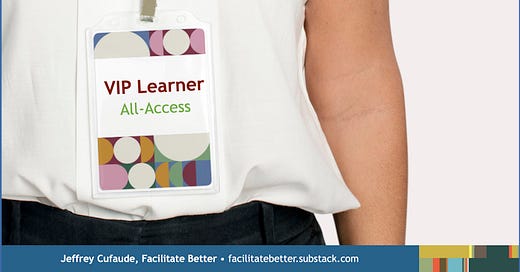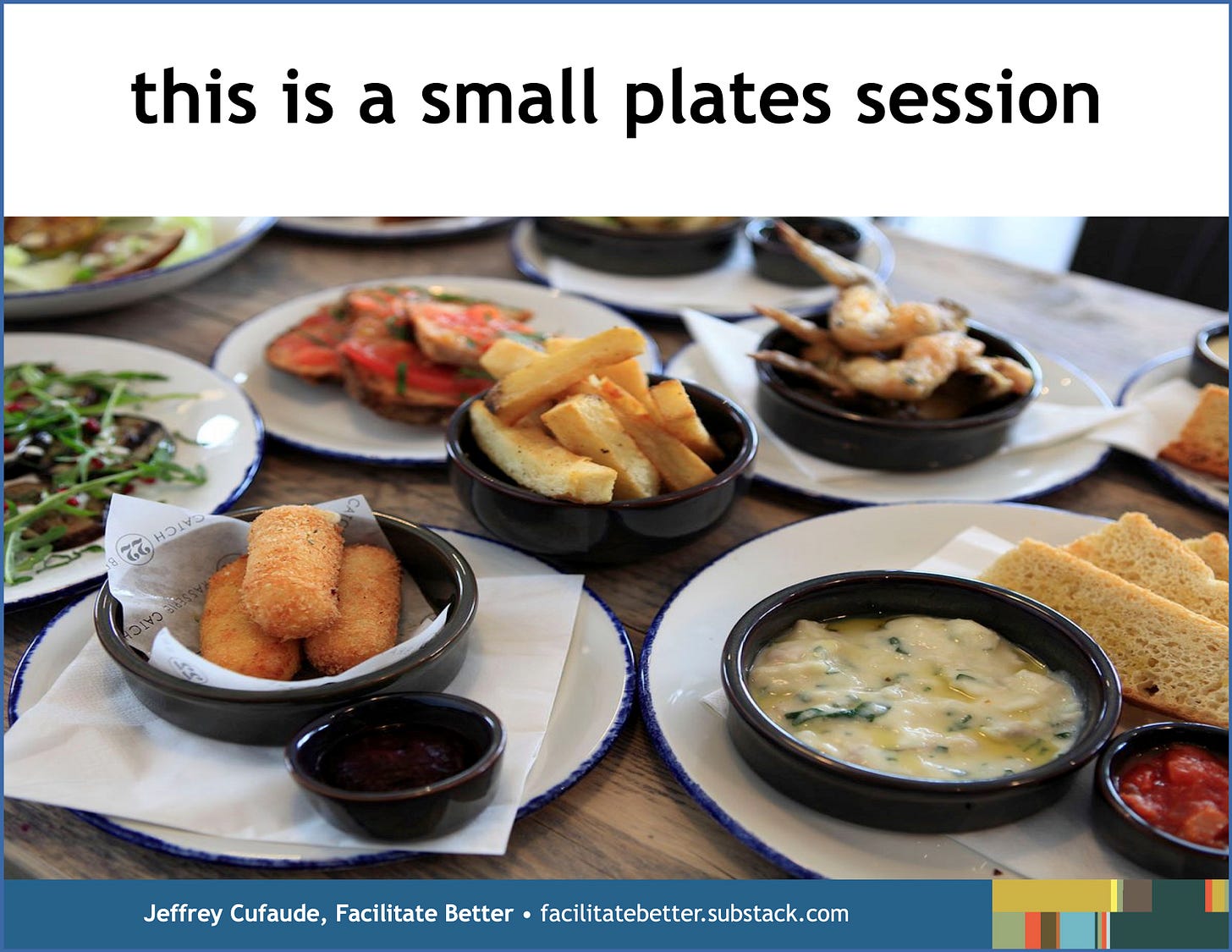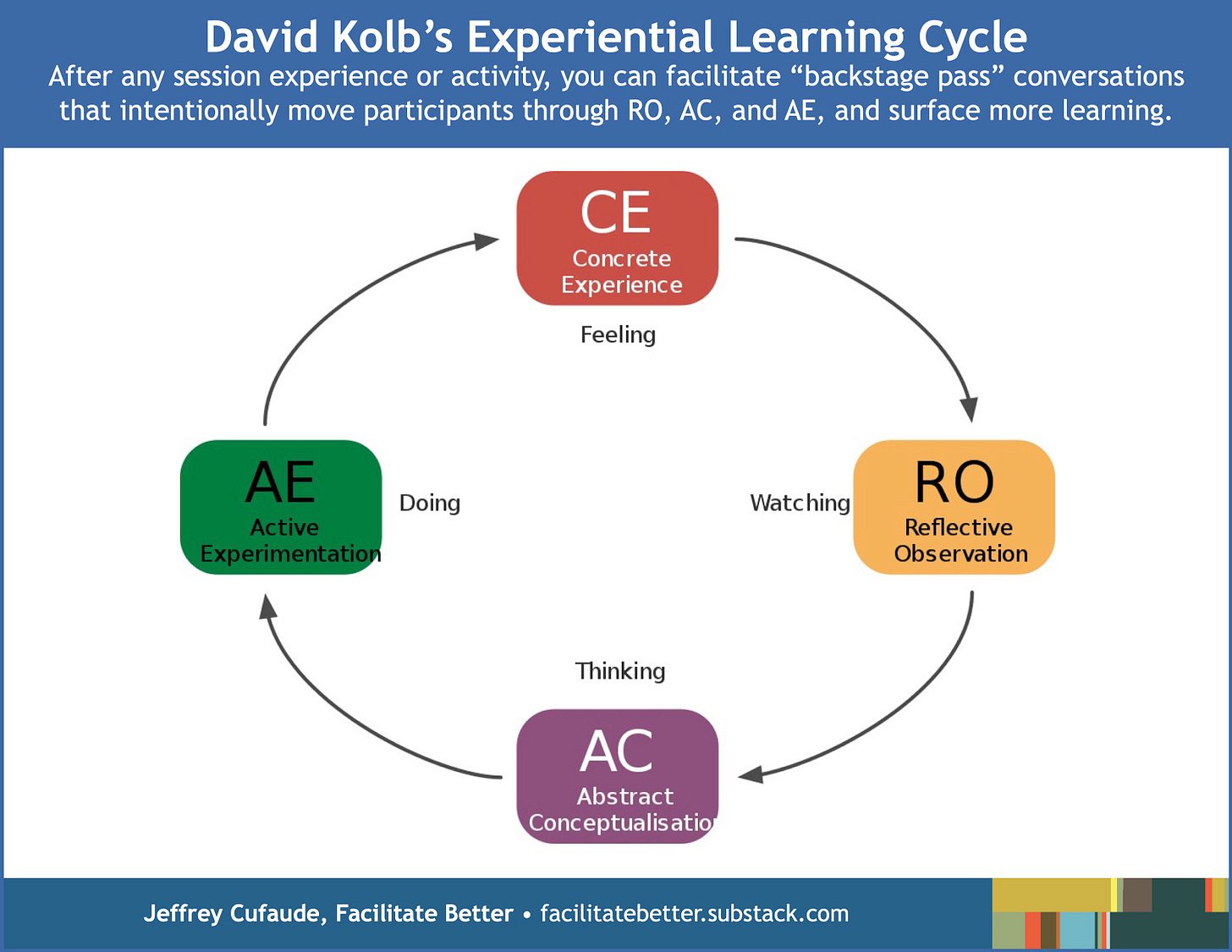Use Backstage Passes to Increase Value and Learning (Facilitation Friday #65)
Here's a detailed look at how I approached designing an engaging, content-rich 60-minute conference session for 250 attendees.
Wouldn’t it be great to “go backstage” and learn the secrets of a successful program, brand, speaker, company, or performer?
People regularly pay extra for special (and usually more intimate) access at concerts, museums, theater productions in London or on Broadway, and major architectural attractions.
Site visits and case studies, two popular professional development offerings, are essentially backstage passes revealing how individuals and organizations do what they do. They often deliver an outsized value because they can be less resource-intensive to plan and provide.
Actors and artists are sometimes reluctant to talk much about their process. Magicians don’t want to reveal the magic behind their tricks and illusions. But I am a big believer in “working out loud” and giving people a sneak peak into one’s efforts.
Behind the Scenes of a Conference Workshop
I was reminded of WOL’s value during a recent consultation call to help someone design an engaging and content-rich 60-minute workshop.
As part of the call prep, I had this individual read a short essay I once published about designing such a session for ASAE's Marketing, Membership, and Communications Conference in Washington, DC. She found it valuable and a great springboard for our conversation.
Since that information is no longer online, I updated it for this post. This behind-the-scenes look offers ideas and insights you can adopt and adapt for your own efforts. Your questions and comments are welcome.
Workshop Topic
Cultivating Engagement and Transforming Results Using Lean Principles
Likely Audience Composition
association marketing, membership, and communication professionals
predominantly from associations with 21-50 staff
often in a director-level position
heavy on Millennials and Generation Xers
some consultants and business partners
Audience Size
Unknown in advance as participants select from five options, but my session was assigned to two ballroom sections set in crescent rounds with a capacity around 250. I ended up maxing out my seating with another 10-15 standing at any given time!
Session Timing
60-minute concurrent session (11:30 a.m. - 12:30 p.m.) on the first day of conference. The day opened with a general session and keynote followed by the first round of concurrent sessions. Lunch in the exhibit hall followed my session.
Session Handouts
Available online in advance, but I assumed most participants would not have them on-site. I brought tabloid-sized copies of my "lab" worksheet so each table would have a couple to work on during a practical application segment.
Session Design Considerations and Assumptions
Some of the considerations and assumptions that informed my content and learning format choices for the session were:
Attendees will value practical more than theoretical given their organization size and job responsibilities, but will still want some new twist or insight to stimulate fresh thinking.
I should provide a learning experience that honors the conference mantra for education: Shake up business-as-usual!
Because attendees vary in functional responsibilities and interests, offer options in any practical application exercises so they can do work they find meaningful.
Since the session is late in the morning, include a "get up and move" activity early on and a hands-on component in the final third, ones that engage both introverted and extroverted learners.
In the spirit of “train the trainer” sessions, include a practical tool or template participants can use with colleagues after the conference to help inform their work.
60-minutes is relatively short. Keep presentation segments concise. Plan for tighter clock management than usual. Socialize participants’ expectations upfront.
Effective presenters and facilitators design for the time we have, not the time we desire. Edit content ruthlessly to ensure participants experience the session as focused, hands-on, and fast-paced, but never rushed.
Many attending will not know lean principles. Introduce them, but focus on their application to cultivating member engagement versus fostering a deep understanding of them overall.
Subsequent Session Design Decisions
Drawing on these eight considerations and assumptions, as well as overall logistics, I brainstormed a variety of content and format possibilities. Here is the ultimate content flow that I presented. As is my norm, I dispensed with the energy-deflating long-winded intros and logistics at the start, dropping that info in as needed
Raise Your Hand Poll (3 minutes)
One question with a bit of discussion: Is the session content "need to know" or "nice to know" for you and your organization?
This surfaced a quick take on their needs, as well as illustrated how to immediately use insight from a simple question, a point I stressed later in the session. For about 65% of the attendees this was a “need to know” session. As such, I was especially vigilant to connect general ideas and themes to their specific implications and applications throughout the session.
Framing the Session (4 minutes)
As I’ve written about before, how one frames sessions, issues, or ideas can dramatically influence results. I used the analogy of tapas to help shape expectations for what I could deliver in 60 minutes, as well as the experience overall: you’ll taste a little of everything, but may leave a bit hungry for more of some things.
Three Major Content Segments (app. 45 minutes)
Define success for cultivating member engagement.
Introduce lean principles with a practical association example for each.
Participants apply lean principles and success definition(s) to three association "defining moments" using a worksheet I created.
Closing (5-7 minutes)
Very brief Q&A and/or summary of my core thinking and key session takeaways.
Content Segments Deep Dive
Content Segment #1 (app. 15 minutes)
I used my simple multi-round Prospecting format. After individually noting responses to my Conversation Catalyst—What is the intention or goal for any cultivation efforts?—participants freely mixed and mingled beyond their tables, quickly swapping responses with others. They then returned to their tables and shared one idea picked up from prospecting.
Prospecting honors both introverted and extroverted learners, quickly moves people from passive participants to active learners and teachers, and non-threateningly engages them with diverse perspectives. Plus, since I knew the "lab work" would be done at their tables, I didn't want the opening interaction to only include talking to those same people.
I closed this segment with my own response to the original question posed, introducing it as a promising premise to guide engagement cultivation:
Successful cultivation efforts accelerate members’ value acquisition.
Knowing that my assertion might differ from some shared during prospecting, I invited participants to “try it on for size” during the subsequent work in the session, but to feel free to use their own success definitions. I did note that the Prospecting activity itself modeled how to accelerate value acquisition during a workshop.
Opportunity Knocks: This summer I’ll offer a Prospecting Train the Trainer Kit with the facilitator instructions, slides, and handout originals so you can use it in your own efforts.
Content Segment #2 (app. 15 minutes)
Introduce the five lean principles and a practical example of each in a short presentation segment followed by brief Q&A. I illustrated lean principles with actual MM&C conference examples since the experience was a common frame of reference.
Content Segment #3 (app. 15 minutes)
The third segment, the lab or practical application time, was a 10-minute table exercise using my worksheet (above). The emphasis was less on producing polished responses and more on experimenting with applying the session content to common situations.
Participants could choose both how they would do the work—individually, as one table, or in any combination—and which of three possible association defining moments to practice using lean principles to cultivate engagement:
you just joined
you just registered for a conference
you just completed a volunteer interest form
Wanting this exercise to both have value and unfold quickly, I first offered one possible set of responses to the worksheet categories for someone who just joined an association. My hope was that this concrete example would accelerate their practical application conversations. This modeling is one way to help ensure small group work is meaningful and efficient.
After reconvening people from the lab work, eight minutes remained in the session … time for three questions and my closing.
What I Would Do Differently
For a first time outing I was pleased, particularly given the unexpectedly large crowd attending and the amount of useful content covered in an engaging manner. Participant evaluations placed my workshop in the top 10% of those offered, and many individual comments affirmed my session design considerations and choices. Attendees also offered great thoughts about ways to enhance the session value.
Based on this feedback and my own observations after reflecting on the workshop, here is what I might do differently if I present a similar session again:
Further limit and tighten my presentation comments to sneak in a few more participant questions.
Improve the worksheet with a bit more detail and slightly revised headings.
Offer the lab activity instructions on either a table handout or the worksheet itself in addition to displaying them on a slide.
Consider including a sample response (in grayed text) in each worksheet column for one of the three application scenarios similar to the verbal walk-through I offered before the table exercise.
Bonus Idea
When appropriate and time permits at the end of any meeting or workshop, include a bit of backstage pass reflective discussion. You can draw on Kolb’s Experiential Learning Cycle for the discussion questions to pose.
Bottom Line
Backstage passes offer additional value and learning and can take a variety of forms, including: freestanding programs that explore the why and how behind the what of something that interests potential participants; a behind-the-scenes debrief and look at what happened in a meeting or workshop; and, anyone, regardless of role or responsibilities, simply “working out loud,” sharing their efforts and lessons learned in presentations and publications as done here.
Getting in Action
If you were to attend a backstage pass learning experience, what elements might you want included to increase its value for you and your efforts?
How might you and/or your organization offer meaningful mission-related backstage pass opportunities that your stakeholders would value and/or improve upon those you already offer?
What is a doable look behind the scenes of your efforts that you could share in a blog post, online comment, article for publication, or conference presentation to help contribute to others’ professional or personal development?
© Facilitate Better and Jeffrey Cufaude. All rights reserved.
To affordably license this content for reprint on your site or in electronic or print communications or to contact me regarding customized facilitation skills workshops or consultations, complete this form.







